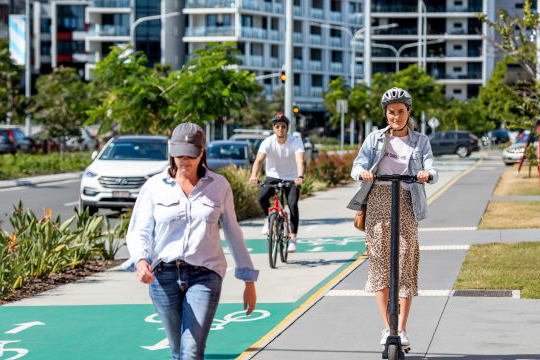E-Mobility Rebate Scheme
The E-Mobility Rebate Scheme offers rebates to reduce the upfront cost of purchasing a new eligible e-bicycle or e-scooter, encouraging the uptake of safe e-mobility devices as a more active and sustainable mode of transport.

The E-Mobility Rebate Scheme closed to new applications on 25 October 2024 as scheme funds have been fully allocated.
As part of Queensland's Zero Emission Vehicle Strategy 2022-2032, the Queensland Government has committed $2 million to the E-Mobility Rebate Scheme to provide Queensland residents with rebates to reduce the upfront cost of purchasing a new eligible e-bicycle or e-scooter.
The Scheme seeks to reduce transport emissions and promote the safer usage of e-mobility devices by encouraging the uptake of high-quality e-bicycles and e-scooters for active transport.
It was expected that the scheme would be popular, and funding would be exhausted quickly. Rebate funding is not guaranteed. Completed applications will be assessed at any stage of the application process and applications will be assessed in order of receipt.
If used safely and in compliance with the rules, e-scooters and e-bicycles offer significant environmental and social advantages by reducing greenhouse gas emissions, easing traffic congestion, promoting health, and improving the accessibility of transportation.
The Queensland Government’s nation leading safety rules for e-scooters and e-bicycles, combined with significant penalties and police enforcement, send a clear message to riders that unsafe and antisocial behaviours will not be tolerated.
Program information
Rebates available for e-mobility devices are:
$500 per eligible e-bicycle (including cargo e-bicycles); or
$200 per eligible e-scooter.
If the cost of the eligible device is below $500 (inclusive of GST) for an e-bicycle or below $200 for an e-scooter; the rebate amount received will be the cost of the device.
An applicant may only receive one rebate under the Scheme. Up to three individuals per household can apply for a rebate.
QRIDA is administering the Scheme on behalf of the Department of Transport and Main Roads.
Am I eligible?
To be eligible for a rebate under the Scheme, you must:
purchase your new eligible e-bicycle or e-scooter from a Queensland retailer or Australian online business on or after 23 September 2024;
be a person aged 18 years or over; and
be a Queensland resident.
You are not eligible for a rebate if you are:
a business (including sole traders, companies, consortiums or organisations)
a person under 18 years of age
a non-Queensland resident
an applicant who have previously received assistance under the Scheme.
What devices are eligible?
For an e-bicycle or e-scooter to be eligible for a rebate under the Scheme, the device must:
be new (e.g. has not been used or sold prior to purchase)
comply with the definition of either an e-bicycle or e-scooter (see Section 12: of the Guidelines);
be limited, by software or hardware, to a maximum speed of 25km/h under motorised power;
include a battery management system; and
be supplied with a charger that has the regulatory compliance mark and is registered on the Electrical Equipment Safety System national database.
Under the Scheme, an e-scooter must:
be designed for use by one person;
have one wheel at the front, and one or two wheels at the back, or, one or two wheels at the front and one wheel at the back;
be propelled by an electric motor that is not capable of operating when a device is going faster than 25km/h;
be steered by handlebars;
have a footboard supported by the wheels; and
be no more than: 1,250mm in length, 700mm in width, 1,350mm in height and 60kg in mass (when not carrying a person or other load).
Under the Scheme, an e-bicycle must:
be a power-assisted bicycle, that is:
be fitted with one or more electric auxiliary motor/s with a maximum power output, or combined maximum power output of not more than 200 watts; and
not be capable of travelling faster than:
6km/h when propelled only by the electric motor/s (no pedalling), or
25km/h while the motor/s are providing assistance (speeds in excess of 25km/h are only permitted under pedal power only), and
not be fitted with an internal combustion engine; or
be an electrically power-assisted cycle (EPAC) with a maximum continuous rated power of 250 watts, of which the output is:
progressively reduced as the cycle’s travel speed increases above 6 km/h; and
cut off, when:
the cycle reaches a speed of 25 km/h; or
the cyclist is not pedalling and the travel speed exceeds 6km/h
Frequently asked questions
If your application is successful QRIDA will reimburse the funds to your nominated bank account if you have provided evidence of already paid invoices.
No, rebate payments will only be applied to the cost of eligible devices excluding GST.
The following devices are not eligible for a rebate:
non-powered bicycles or scooters
bicycles or scooters fitted with an internal combustion engine (petrol-powered)
e-bicycles with 1 or more electric motor/s capable of generating a combined power output of more than 200 watts (other than an electrically power-assisted cycle (EPAC))
second-hand (including refurbished) e-bicycles and e-scooters
bicycles or scooters that have been retro-fitted with electric motors after they were first sold in Australia
e-bicycle or e-scooter conversion kits
any accessories generally associated with e-bicycles or e-scooters, including but not limited to helmets, baskets, protective clothing etc
e-skateboards, segways, mono-wheels and similar
electric/motorised wheelchairs and mobility scooters
e-scooters or e-bicycles that can travel over 25km per hour under operated power – unless limited by software or hardware.
Generally, the product specifications will outline the make and model of the device itself.
The battery charger is normally considered an accessory, so you may need to visually inspect the chargers and look at the rating label to record the brand name of the charger (which could be different to the brand of the e-scooter or e-bike). Or you can ask the supplier for the brand and model of the charger. You should check for the registration of the charger via the National Equipment Registration System.
If you cannot find the registration, either ask the supplier to prove it is registered or don't buy it.
To ensure your device and charger comply with the eligibility requirements you may need to speak with your retailer and seek advice.
Queensland has nation leading safety rules for e-scooters and e-bicycles, and, when combined with significant penalties and police enforcement, send a clear message to riders that unsafe and antisocial behaviours will not be tolerated.
It’s important to note that to ride an e-scooter you must be either at least 16 years or at least 12 years and supervised by an adult while riding the device. E-bicycle and e-scooter riders must obey all Queensland Road Rules.
E-scooters can be ridden on footpaths, shared paths, bike paths, and local streets and on-road bike lanes where the road limit is 50km/h or less, or if physically separated from other lanes of traffic (for example, by bollards).
E-bikes can be ridden on most paths and roads, although riders are encouraged to consider a safe, bicycle friendly route.
For more information, see the links below:
Yes, you are entitled to a decision review. See reviewing a decision for more information.
The scheme has allocated $2 million. Rebate funding is not guaranteed at any stage of the application process and applications will be assessed in order of receipt.
QRIDA will contact you via telephone, email, SMS or post. Should you be concerned about whether contact you have received is genuine, please contact QRIDA on 1800 623 946.
QRIDA is committed to ensuring due administrative processes are undertaken with the decisioning of applications for Government assistance.
When making decisions on applications, as well as the internal review of a decision, QRIDA follows the QRIDA Decision-Making Policy and Procedure.
You can view this Policy and Procedure on the Reviewing a decision page.

